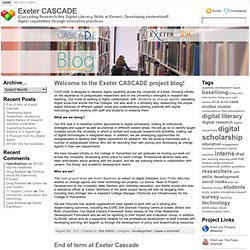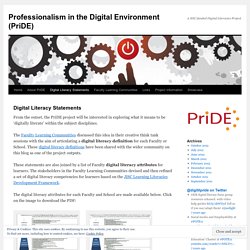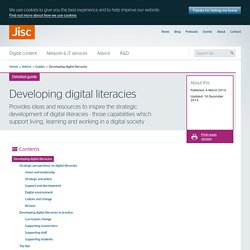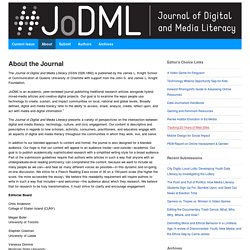

Developing digital literacies in the curriculum - slidedeck - Google Slides. Jiscdesignstudio.pbworks. Exeter CASCADE. Here at the Exeter Uni’s Teaching and Learning Conference, Helen and I set up a stall for the Exeter CASCADE project, which got a lot of traffic.

First of all, let me explain why we stood out from the crowd. Every other stall looked like this: And our stall looked like this: So besides my excitement about wearing my favorite Hawaiian dress, what else happened? We talked to a lot of people, and a big rang of people too. We asked people to fill in papers and leave them in a bottle, a ‘message in a bottle’ responding to the statement ”Help! Like our conversations, the responses on our wall wiki and our bottle brought out a lot of the contentious nature of the whole ‘digital literacy’ thing.
‘Help! Because people’s relationships with technology are different, and because people are different, I guess it makes sense that people would have some different answers to that statement. The answers to the question ‘how is digital technology changing your discipline?’ Professionalism in the Digital Environment (PriDE) From the outset, the PriDE project will be interested in exploring what it means to be ‘digitally literate’ within the subject disciplines.

The Faculty Learning Communities discussed this idea in their creative think tank sessions with the aim of articulating a digital literacy definition for each Faculty or School. These digital literacy definitions have been shared with the wider community on this blog as one of the project outputs. These statements are also joined by a list of Faculty digital literacy attributes for learners. The stakeholders in the Faculty Learning Communities devised and then refined a set of digital literacy competencies for learners based on the JISC Learning Literacies Development Framework. The Design Studio / Student survey.doc. 20 Things Educators Need To Know About Digital Literacy Skills. Widely understood to be essential to success in the workplace and modern life, digital literacy is beginning to emerge as a necessary component of curricula across the globe.

As current undergraduates have never known a life without the internet, it’s only natural that universities should nurture their familiarity with technology, encouraging its use in teaching and learning. Instructors should also be prepared to offer guidance on what students aren’t as familiar with–turning their technical skills into skills for lifelong learning and employability. But where does one begin? Teaching digital literacy is about more than just integrating technology into lesson plans; it’s about using technology to understand and enhance modern communication, to locate oneself in digital space, to manage knowledge and experience in the Age of Information. Digital literacy isn’t about knowing computers inside and out; it’s about using technology to change the way you think. 1. 2. 3. 4. 5. 1. 2. 3.
Digital_and_Media_Literacy_A_Plan_of_Action.pdf. Digital and Media Literacy: A Plan of Action. The Knight Commission recognized that people need tools, skills and understanding to use information effectively, and that successful participation in the digital age entails two kinds of skills sets: digital literacy and media literacy.

Digital literacy means learning how to work the information and communication technologies in a networked environment, as well as understanding the social, cultural and ethical issues that go along with the use of these technologies. Media literacy is the ability to access, analyze, evaluate, create, reflect upon, and act with the information products that media disseminate. Coming the day after U.S. “Full participation in contemporary culture requires not just consuming messages, but also creating and sharing them,” writes Hobbs. “To fulfill the promise of digital citizenship, Americans must acquire multimedia communication skills and know how to use these skills to engage in the civic life of their communities.” Download PDF | View on Scribd. Digital and Media Literacy: A Plan of Action. Developing digital literacies. Digital literacies are those capabilities which fit an individual for living, learning and working in a digital society.

Digital literacy looks beyond functional IT skills to describe a richer set of digital behaviours, practices and identities. What it means to be digitally literate changes over time and across contexts, so digital literacies are essentially a set of academic and professional situated practices supported by diverse and changing technologies. This definition quoted above can be used as a starting point to explore what key digital literacies are in a particular context eg university, college, service, department, subject area or professional environment. Atomic Object TECHNOLOGY SHOWCASE. 20 Things Educators Need To Know About Digital Literacy Skills. SUNY - Tools of Engagement Project (TOEP) Journal of Digital and Media Literacy. The Journal of Digital and Media Literacy (ISSN 2326-1862) is published by the James L.

Knight School of Communication at Queens University of Charlotte with support from the John S. and James L. Knight Foundation. JoDML is an academic, peer-reviewed journal publishing traditional research articles alongside hybrid, mixed-media articles and creative digital projects. Our goal is to examine the ways people use technology to create, sustain, and impact communities on local, national and global levels. University of Liverpool - Developing Digital Literacies.